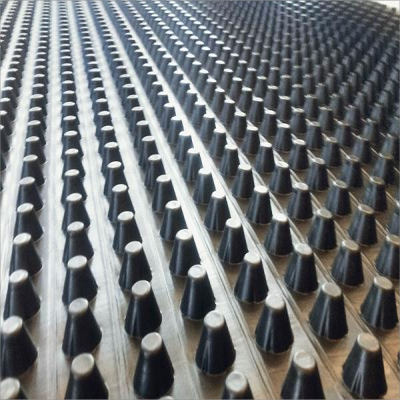1. Plastic Drainage plate The basic composition and characteristics of
The plastic drainage board is made of high-density polyethylene ( HDPE) Or polypropylene ( PP) Made of such polymer materials, it has the characteristics of light weight, high strength, corrosion resistance and aging resistance. Its surface is designed with drainage channels, which can collect and drain water from the soil, accelerate foundation consolidation and improve soil bearing capacity.
2. Construction technology of plastic drainage board
1、Construction preparation
Before construction, the foundation should be cleaned and leveled to ensure that there is no debris and sharp objects. According to the design requirements, a certain thickness of gravel drainage layer should be laid and rolled and leveled to provide a foundation for the subsequent insertion of drainage boards.
2、Insert drainage board
Inserting drainage board is a key step in construction. According to the design drawings, use tools such as guide frame and vibrating hammer to align the sleeve with the socket position and sink. After passing the plastic drainage board through the sleeve, it is connected with the anchor shoe at the end. The casing is resisted to the anchor shoe, and the drainage board is inserted to the designed depth. After pulling out the casing, the anchor shoe is left in the soil along with the drainage board.
3、Deviation detection and adjustment
During the insertion process, the verticality and spacing of drainage boards should be strictly controlled. Use tools such as theodolite or weight to ensure that the drainage plate is inserted vertically and the deviation does not exceed the specified range. Also check whether the connection between the drainage plate and the pile tip is secure to prevent the core plate from being brought out when pulling out the casing.
4、Cut-off vs. Landfill
After the insertion is completed, according to the design requirements, cut off the end of the drainage board higher than the ground, dig up the sand into a bowl-shaped concave position, cut off the exposed board head and fill it. Make sure the drainage board is in close contact with the sand cushion to create a good drainage channel.
5、Quality inspection and acceptance
After the construction is completed, the quality inspection of the drainage board should be carried out, including the test of tensile strength, elongation, tear resistance and other indicators. Also check that the continuity, spacing, and depth of the drainage boards meet the design requirements. Follow-up construction can only be carried out after acceptance.
3. Precautions for the construction of plastic drainage board
1、Material selection: Select plastic drainage board that meets national standards and design requirements to ensure its performance and quality.
2、Construction machines and tools: Use professional construction machines and tools, such as guide frames, vibrating hammers, etc., to ensure insertion accuracy and efficiency.
3、Construction environment: Check the geological conditions before construction, and avoid inserting drainage boards at underground obstacles. Also pay attention to the safety and environmental protection of the construction site.
4、Quality control: Strictly control the insertion depth, spacing and verticality of drainage boards to ensure that the construction quality meets the design requirements.
5、Post-maintenance: After the construction is completed, the drainage effect of the drainage board should be checked regularly, and the blocked and damaged drainage channels should be cleaned up in time.
As can be seen from the above, the construction process of plastic drainage board involves multiple links and details, and the construction quality must be strictly controlled to ensure that the drainage effect meets the design requirements.
Post time: Mar-03-2025




